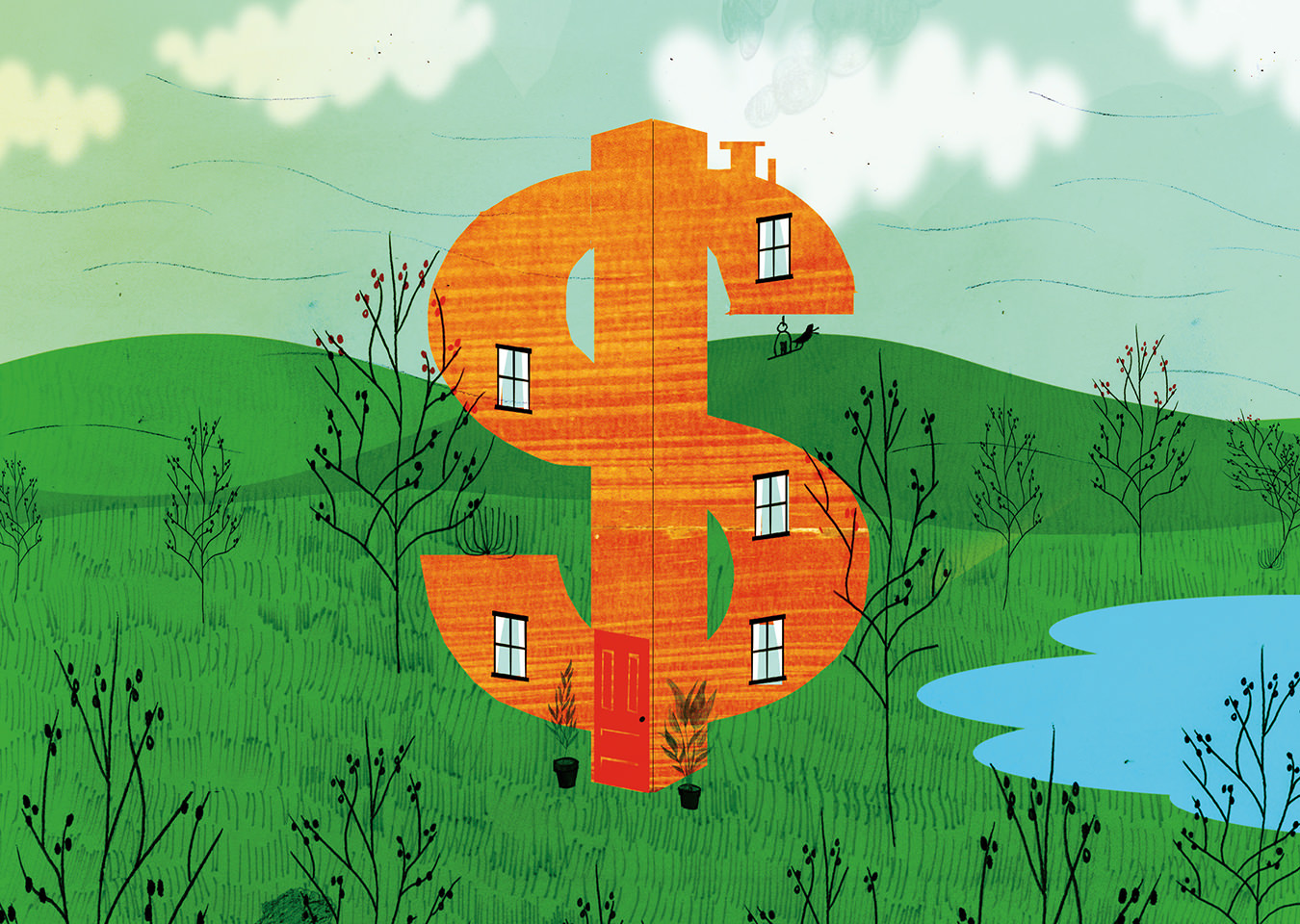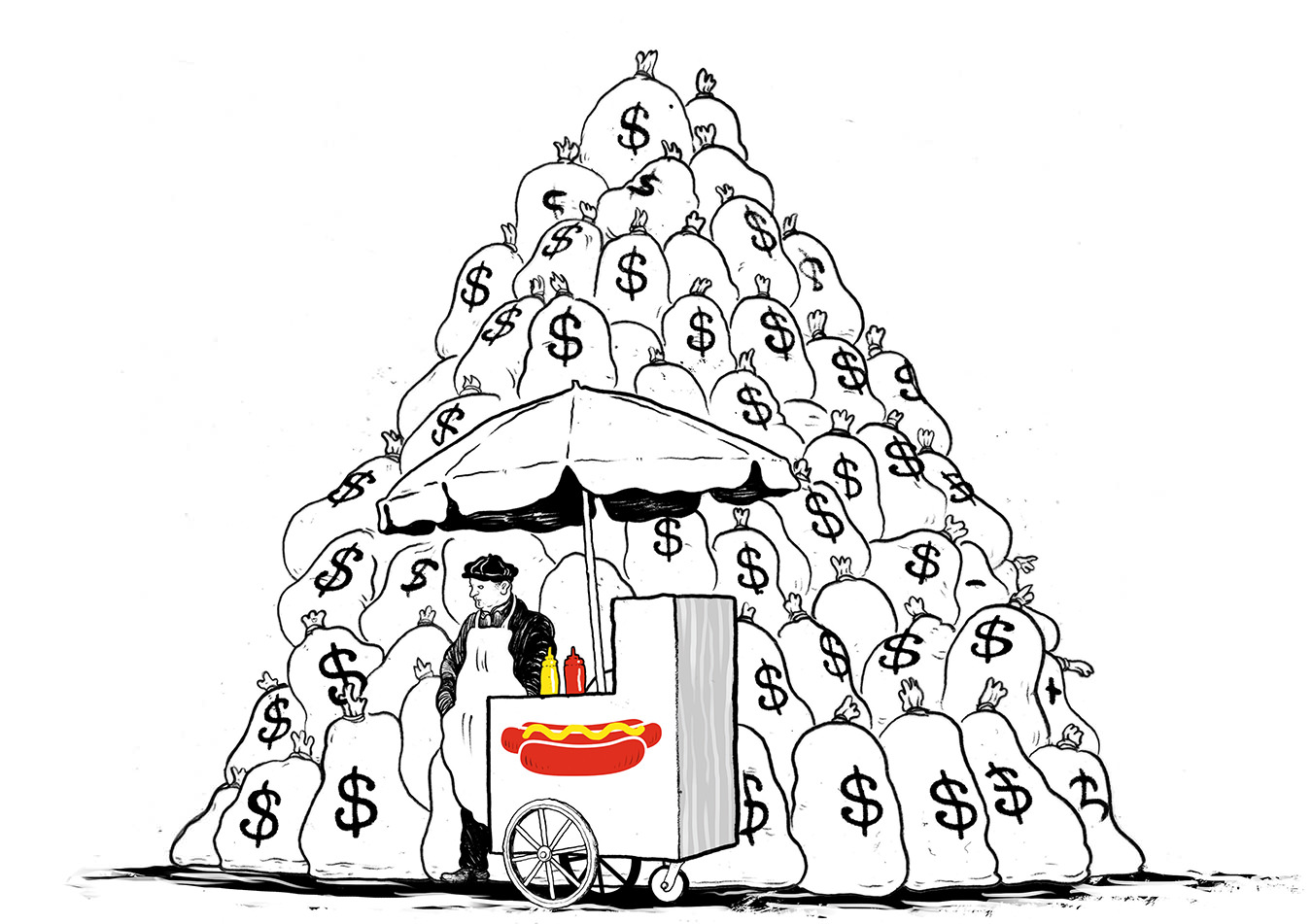Second Home, Prime Opportunity
Is now the time to invest in recreational real estate?

Illustration by Maxwell Holyoke-Hirsch
If a man’s home is his castle, then a man’s cottage is his Versailles: a home away from home that is as much a sanctuary as it is a residence. Whether it be an uninsulated shack on the side of a distant mountain or a 10-bedroom mansion on the shore of a lake, the cottage is the ultimate escape—from noise, pollution, people, routine, responsibilities, the rat race, civilization itself—if only from Victoria Day to Labour Day.
It can also be a darn fine investment. For most of the past decade, recreational property has been an excellent place to put one’s money, in no small part because of the ubiquitous baby boomers seeking respite from the hustle and bustle of big-city life. Such was the prediction put forth by demographer David K. Foot in his seminal Boom, Bust & Echo: How to Profit from the Coming Demographic Shift as far back in 1996. The argument went something like this: As the Canadian population grows older, peace and quiet becomes more appealing. Demand for urban and suburban homes drops. Demand for homes overlooking golf courses, ski runs, glacial lakes, and a variety of other scenic vistas increases. And that little piece of the great outdoors becomes the best investment you ever made.
Case in point: Whistler, British Columbia. Founded in 1914 as a railway rest stop between logging towns, the resort has become one of the world’s premier ski destinations, with real estate prices as high as the snow-kissed peak that bears the town’s name. Back in 1980, a far-sighted speculator could have purchased waterfront property on Alta Lake (since incorporated into Whistler Township) for about $10,000. Thirty-odd years later, that same lot goes for anywhere from $1-million to $1.5-million depending on the exact address—an increase of about 15 to 17 per cent a year.
Impressive numbers. But investing in second homes is anything but a sure thing. Like fine Burgundy and Grandma’s porcelain tea set, second homes cannot rightly be considered necessities. As such, they are usually one of the first things to be tossed over the side of the boat in the event of a financial storm. For investors, that can make the recreational market subject to considerable swings and gyrations as prices move in step with the overall economic health of the nation.
For proof, one need only peruse the annual Re/Max Recreational Property Report, which lists the average starting price for a three-bedroom winterized home in most of the country’s best-known recreational areas. Back in 2008, the price for a waterfront home in British Columbia’s Okanagan Valley was about $1.5-million; in 2011, you could have picked it up for $995,000. In Canmore, Alberta, what you paid $320,000 for in 2008 would now be worth about $229,000. Ontarians have fared better: prices in many parts of Muskoka have held steady over the past four years, and in some places (Parry Sound, for example) they have actually increased.
So which is it then: Get-rich-quick scheme or money pit? Can second homes be a first-tier investment opportunity? Or is it an activity better left to those with seven-figure bank accounts? In a world painfully short on investment certainty, is that cottage you’ve had your eye on your best hope for a lifetime of abundance and plenty? Or is it the biggest boondoggle on the lake?
Where the Deals Are
If anyone in Canada has the answers to such weighty questions, it’s Ross McCredie. As the president and CEO of the Canadian arm of luxury real estate brokerage Sotheby’s International, it’s McCredie’s job to know where the deals are when it comes to the recreational real estate market in Canada, the United States, and around the world.
From where McCredie stands, the investment case for recreational real estate still makes a lot of sense. But the rationale has less to do with demographic shifts than it does with the law of supply and demand. “As far as the demographic argument goes, it’s been out there for years,” McCredie says. “A lot of that does not hold water for all developments and regions.” As he explains, when it comes to vacation property, there are only so many postcard-perfect lakes to go around. “Wealthy boomers want to be where other wealthy boomers are,” he notes. “That real estate is limited and appreciating exponentially.”
For this reason, McCredie believes better times are ahead for the Canadian recreational market. “The recreational market has had a difficult time,” he admits. “But the foundation has been laid so that most of those properties that have gone through a difficult time are now coming back from their price corrections.”
While many analysts and pundits have used the B-word to describe the Canadian residential market (particularly when talking about Toronto and Vancouver), McCredie sees no evidence of an asset bubble in cottage country. “In the recreational [market], I don’t see it anywhere in terms of it being overheated,” he says. “If anything, it’s a fairly stable market. If you’re looking at single-family waterfront lots and homes, there’re all doing pretty well.”
While capital appreciation and rental income is all well and good, the real reason to buy recreational real estate is because you’ve fallen in love with a particular part of the world. In other words, focus on the R&R, not the ROI.
South of the border, however, things don’t look quite so rosy. After suffering the worst economic downturn in 80 years, the U.S. real estate market is still reeling from foreclosures, lack of liquidity, and an overall malaise among buyers. Traditional Sunbelt destinations such as California, Arizona, and Florida were hit particularly hard, with prices in some markets down more than 30 per cent from their highs. Buyers can find tremendous deals there, but as McCredie points out, they can also find a fair bit of financial danger.
“The U.S. has a ton of opportunity in terms of when you come down and look to buy property,” he says. But not every property is a slam dunk. “I think [it] is a very, very difficult space to navigate, and [there is] a lot of really bad real estate that should never have been developed in the first place.”
If what you’re looking for is a basic one-bedroom condo in a built-up urban centre in the States, McCredie says the time to buy is now. (“There are some really good opportunities there,” he acknowledges.) But if you’re looking for a traditional resort-type property, or if your tastes tend to be more luxurious, he believes the news of screaming-hot deals needs to come with a big caveat: “The stuff that’s priced at the lower threshold—that product has a lot of problems with it, it’s not nearly as nice as they think it is.”
If anything, McCredie believes that when it comes to the recreational market, the old adage about getting what you pay for is still very much true. “Most of those deeply discounted properties weren’t in great locations,” he says. “People are coming in and buying these homes for what they think is a song. But the reality is, on a long-term basis, these developments are not going to get anywhere in terms of capital appreciation—they’re always going to be troubled developments.”
Return on R&R
Ready to dip your toes into the recreational property market? McCredie preaches financial caution. “The first thing is, make sure you can afford it,” he says bluntly. “The worst thing about recreational real estate is having that noose around your neck. When things get tough and you can’t get rid of it, it can destroy marriages, it can destroy families—it can actually be a very, very difficult thing.”
Beyond the financial advice, McCredie tells would-be buyers to keep the true purpose of recreational real estate top of mind. “The main thing is lifestyle,” he says. While capital appreciation and rental income is all well and good, the real reason to buy recreational real estate is because you’ve fallen in love with a particular part of the world. “It’s [for] recreation.” In other words, focus on the R&R, not the ROI.
As far as specific opportunities go, McCredie believes there are a few that deserve consideration. If it’s sunshine and heat that are on your wish list, he likes what he sees in Las Vegas. Along with Palm Springs, Phoenix/Scottsdale, and Miami, Sin City was among the most affected in the financial meltdown of 2008; prices remain in a state of recovery. But as McCredie points out, some 40 million people still visit the city on an annual basis, a statistic that bodes well for real estate over the long term. “[It’s] my number one market that hasn’t moved yet,” he says.
As far as Canadian opportunities go, McCredie offers an unconventional choice: Vancouver. Huh? Canada’s third-largest city is a recreational market? “You have to look at it that way,” McCredie answers emphatically. “[You have to] understand how the rest of the world views Vancouver: they see it as an urban resort. They see it as a world-class city where they’d love to own.”
As McCredie points out, Vancouver has something most recreational markets don’t: net migration. Unlike, say, Parry Sound or the Rideau Lakes, Metro Vancouver is growing at a strong and steady pace—9.3 per cent over the 2006–2011 census period. What’s more, many of new migrants have very deep pockets. “The difference is that it’s a very wealthy immigrant that’s coming in,” McCredie notes. “Or typically people who have invested in Canada for a long time but have become much wealthier.” All of which makes for good times for those who can afford the city’s nosebleedingly high prices.
And what of all that talk of bubbles bursting? McCredie doesn’t pay it much heed. “I see a lot of strength,” he says. “Despite all the rhetoric about how horrible the economy has been, Vancouver is one of the number one cities in the world where wealthy people want to own property. And I don’t see that changing.”




